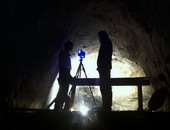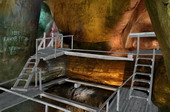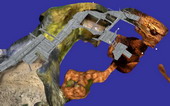 Denisova Cave in the Altai Mountains (Siberia, Russia) is a world famous Paleolithic site (51° 23′ 51.29″ N, 84° 40′ 34.34″ E). Regular archaeological excavations are being performed here since 1982, more than 20 cultural layers were revealed, and more than 80000 finds were collected. In 2008, a new branch in human evolution was discovered based on finds in the Denisova Cave [1]. So it is an actual task to digitally preserve this unique object using up-to-date methods of 3D documentation: i.e. to create virtual (digital) 3D model of the cave and most important finds, and visualize results of archaeological research based on this model.
Denisova Cave in the Altai Mountains (Siberia, Russia) is a world famous Paleolithic site (51° 23′ 51.29″ N, 84° 40′ 34.34″ E). Regular archaeological excavations are being performed here since 1982, more than 20 cultural layers were revealed, and more than 80000 finds were collected. In 2008, a new branch in human evolution was discovered based on finds in the Denisova Cave [1]. So it is an actual task to digitally preserve this unique object using up-to-date methods of 3D documentation: i.e. to create virtual (digital) 3D model of the cave and most important finds, and visualize results of archaeological research based on this model.
 In August 2012, we performed laser scanning and detailed photography of the cave. 37 scan stations were made; full point cloud contains about 50 millions of points. Then we have created a textured polygonal 3D model based on results of laser scanning and photography. The model consists of 88254 polygons: 86000 – the cave and 2254 – artificial objects (decks, rails, and stairs). The resolution of a texture varies for the different parts of the model from 30 to 100 thousands of pixels per 1 square meter of a model surface. Thus we have created a detailed 3D model of a cave that preserves its geometry and appearance with high accuracy and resolution.
In August 2012, we performed laser scanning and detailed photography of the cave. 37 scan stations were made; full point cloud contains about 50 millions of points. Then we have created a textured polygonal 3D model based on results of laser scanning and photography. The model consists of 88254 polygons: 86000 – the cave and 2254 – artificial objects (decks, rails, and stairs). The resolution of a texture varies for the different parts of the model from 30 to 100 thousands of pixels per 1 square meter of a model surface. Thus we have created a detailed 3D model of a cave that preserves its geometry and appearance with high accuracy and resolution.
 The created 3D model was referenced in archaeological coordinate system (ACS), that is used by archaeologists for spatial referencing (registration of location) of finds. The X axis of the ACS is turned 62 grades clockwise from the North direction, the Y axis is perpendicular to X, and the Z axis is vertical. Origin of coordinates of ASC is located in some virtual point in space near the cave entrance. ACS is fixed in the cave by five permanent marks in the cave’s walls. These marks were scanned during the laser scanning. During post processing, the model of a cave was converted in ASC. The accuracy of referencing was about 5 cm (mostly because of errors of marks localization in ASC). Thus we provide a capability for comparison of the 3D model and existing archaeological schemes, and direct transfer of existing archaeological database in a virtual space of the 3D model.
The created 3D model was referenced in archaeological coordinate system (ACS), that is used by archaeologists for spatial referencing (registration of location) of finds. The X axis of the ACS is turned 62 grades clockwise from the North direction, the Y axis is perpendicular to X, and the Z axis is vertical. Origin of coordinates of ASC is located in some virtual point in space near the cave entrance. ACS is fixed in the cave by five permanent marks in the cave’s walls. These marks were scanned during the laser scanning. During post processing, the model of a cave was converted in ASC. The accuracy of referencing was about 5 cm (mostly because of errors of marks localization in ASC). Thus we provide a capability for comparison of the 3D model and existing archaeological schemes, and direct transfer of existing archaeological database in a virtual space of the 3D model.
 We also scanned, photographed and modeled several finds made in the cave (stone implements). Created models of items consist of about 50 thousands of polygons. During texturing, we used normal maps that were built based on more detailed models (500 thousands of polygons). Thus we achieved high visual realism and resolution of virtual models at relatively small size of models and textures. It is particularly important for interactive visualization in stereo mode.
We also scanned, photographed and modeled several finds made in the cave (stone implements). Created models of items consist of about 50 thousands of polygons. During texturing, we used normal maps that were built based on more detailed models (500 thousands of polygons). Thus we achieved high visual realism and resolution of virtual models at relatively small size of models and textures. It is particularly important for interactive visualization in stereo mode.
In order to visualize the created 3D model of the cave, we have developed an interactive 3D presentation (software based on OpenSceneGraph). The presentation supports both mono- and stereoscopic visualization. It provides visualization of a point cloud, 3D model of the cave, 3D models of finds, 3D models of wooden decks, rails and stairs, as well as visualization of the spatial distribution of finds in different archaeological layers («cloud of finds»). It also supports visualization of additional data: cardinal directions, axes and grid of ASC, location of permanent marks of ASC. The 3D model of the cave can be virtually cut at any horizontal layer; this option helps to analyze visually the geometry of the cave and localization of finds.
 The presentations have four windows: «Globe», «Cave», «Cloud of finds», and «3D model of an item». User can switch between windows arbitrarily. In the «Globe» window, user can explore the virtual globe with embedded model of a cave, and analyze the location of a cave and surrounding landscape. In the «Cave» window, the 3D model of the cave and other objects are presented. In the «Cloud of finds» window, only the location of archaeological finds is visualized (coordinates of finds, surfaces of archaeological layers, spatial orientation of finds). In the «3D model of an item» window, user can explore 3D models of finds and switch between them.
The presentations have four windows: «Globe», «Cave», «Cloud of finds», and «3D model of an item». User can switch between windows arbitrarily. In the «Globe» window, user can explore the virtual globe with embedded model of a cave, and analyze the location of a cave and surrounding landscape. In the «Cave» window, the 3D model of the cave and other objects are presented. In the «Cloud of finds» window, only the location of archaeological finds is visualized (coordinates of finds, surfaces of archaeological layers, spatial orientation of finds). In the «3D model of an item» window, user can explore 3D models of finds and switch between them.
The created 3D models and software can be used for presentation as well as for research tasks (for example, visual analysis of stratigraphy and deposition of sediments). The presentation can be also used for virtual travel in the cave, including free online tours. It is especially important for such remote and hard to access heritage sites as the Denisova Cave in the Altai Mountains.
The project was performed in 2012 by the Center for Virtual History of Science and Technology of the S.I. Vavilov Institute for the History of Science and Technology of the Russian Academy of Sciences (IHST RAS, Moscow, Russia) together with the Institute of Archaeology and Ethnography of the Siberia Branch of the Russian Academy of Sciences (IAET SB RAS, Novosibirsk, Russia) with support of the Trimetari LLC (St. Petersburg, Russia).
 We wish to thank Svetlana Baykova, Andrey Ivanov, Dmitriy Linovskiy and Ivan Rys (Trimetari LLC) for laser scanning, modeling and texturing of 3D models, Mikhail Shunkov (IAET SB RAS) for his help in organization of a field works, Maxim Kozlikin (IAET SB RAS) for preparation of a source data about location of archaeological finds and useful consultations, and also to Sergey Kotelnikov and Sergey Zelenskiy.
We wish to thank Svetlana Baykova, Andrey Ivanov, Dmitriy Linovskiy and Ivan Rys (Trimetari LLC) for laser scanning, modeling and texturing of 3D models, Mikhail Shunkov (IAET SB RAS) for his help in organization of a field works, Maxim Kozlikin (IAET SB RAS) for preparation of a source data about location of archaeological finds and useful consultations, and also to Sergey Kotelnikov and Sergey Zelenskiy.
Authors
Mikhail Anikushkin (Trimetari LLC, St. Petersburg, Russia), Aleksandr Bobkov, Andrey Leonov (S.I. Vavilov Institute for the History of Science and Technology of the Russian Academy of Sciences, Moscow, Russia).
Literature
[1]. Johannes Krause, Qiaomei Fu, Jeffrey M. Good, Bence Viola, Michael V. Shunkov, Anatoli P. Derevianko, and Svante Pääbo. The complete mitochondrial DNA genome of an unknown hominin from southern Siberia // Nature. № 464. P. 894—897 (8 April 2010).

